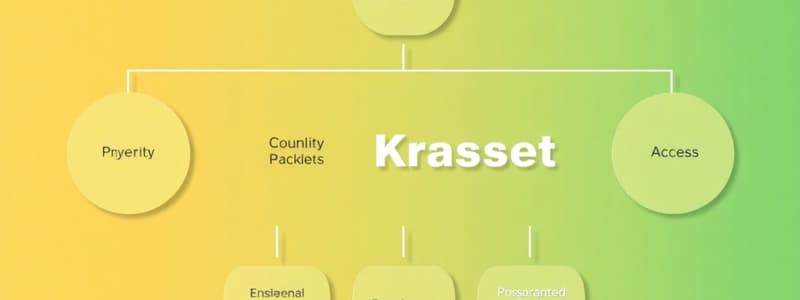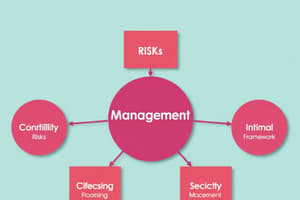Podcast
Questions and Answers
Which component of the COSO framework emphasizes the importance of leadership direction and company culture?
Which component of the COSO framework emphasizes the importance of leadership direction and company culture?
- Control Environment (correct)
- Risk Assessment
- Info & Communication
- Monitoring
What is the primary purpose of an Acceptable Use Policy in an organization?
What is the primary purpose of an Acceptable Use Policy in an organization?
- To regulate acceptable behaviors regarding technology use (correct)
- To monitor employee performance
- To ensure data encryption during transmission
- To manage device ownership and personal liability
Which of the following describes the concept of Network Segmentation?
Which of the following describes the concept of Network Segmentation?
- Monitoring network actions on personal devices
- Controlling network traffic to enhance security (correct)
- Reducing risks by minimizing access points
- Encrypting wireless internet connections
In the context of cybersecurity, what does 'System Hardening' aim to achieve?
In the context of cybersecurity, what does 'System Hardening' aim to achieve?
What is a key function of a Virtual Private Network (VPN)?
What is a key function of a Virtual Private Network (VPN)?
Which policy defines personal liability for data on employee devices?
Which policy defines personal liability for data on employee devices?
What is the main focus of the Risk Assessment component of the COSO framework?
What is the main focus of the Risk Assessment component of the COSO framework?
What does WiFi Protected Access aim to achieve?
What does WiFi Protected Access aim to achieve?
What is the primary goal of Zero Trust security?
What is the primary goal of Zero Trust security?
Which of the following best describes Whitelisting?
Which of the following best describes Whitelisting?
What does Multi-Factor Authentication involve?
What does Multi-Factor Authentication involve?
Which access control method allows data owners the authority to manage their own data?
Which access control method allows data owners the authority to manage their own data?
Which of the following is an example of detective controls?
Which of the following is an example of detective controls?
In the context of cybersecurity, what does the Need to Know principle refer to?
In the context of cybersecurity, what does the Need to Know principle refer to?
What type of authentication uses physical characteristics to verify identity?
What type of authentication uses physical characteristics to verify identity?
What is the primary purpose of a Common Vulnerabilities and Exposures (CVE) dictionary?
What is the primary purpose of a Common Vulnerabilities and Exposures (CVE) dictionary?
Which password management recommendation includes changing passwords every 45-90 days?
Which password management recommendation includes changing passwords every 45-90 days?
Which of the following is a component of layered security?
Which of the following is a component of layered security?
What feature primarily differentiates Role-Based Access Control from other access control types?
What feature primarily differentiates Role-Based Access Control from other access control types?
What does the term 'defense in depth' primarily refer to in cybersecurity?
What does the term 'defense in depth' primarily refer to in cybersecurity?
What is a key characteristic of context aware authentication?
What is a key characteristic of context aware authentication?
Which type of access control is managed consistently by administrators?
Which type of access control is managed consistently by administrators?
Flashcards
Security Policy
Security Policy
A document that outlines the organization's approach to safeguarding information during storage, transmission, and processing.
Acceptable Use Policy
Acceptable Use Policy
A policy specifying acceptable uses of technology resources, including employee responsibilities, acceptable behaviors, and consequences for violations.
Bring Your Own Device (BYOD) Policy
Bring Your Own Device (BYOD) Policy
A policy allowing employees to use their personal devices for work, while setting guidelines for security and data protection.
Network Segmentation
Network Segmentation
Signup and view all the flashcards
Service Set Identifier (SSID)
Service Set Identifier (SSID)
Signup and view all the flashcards
Virtual Private Network (VPN)
Virtual Private Network (VPN)
Signup and view all the flashcards
System Hardening
System Hardening
Signup and view all the flashcards
Database Hardening
Database Hardening
Signup and view all the flashcards
Authentication Technology
Authentication Technology
Signup and view all the flashcards
Multi-factor Authentication
Multi-factor Authentication
Signup and view all the flashcards
Zero Trust
Zero Trust
Signup and view all the flashcards
Least Privilege
Least Privilege
Signup and view all the flashcards
Whitelisting
Whitelisting
Signup and view all the flashcards
Multimodal Biometrics
Multimodal Biometrics
Signup and view all the flashcards
MAC Filtering
MAC Filtering
Signup and view all the flashcards
Layered Security
Layered Security
Signup and view all the flashcards
Abstraction
Abstraction
Signup and view all the flashcards
Common Vulnerabilities and Exposures (CVE) Dictionary
Common Vulnerabilities and Exposures (CVE) Dictionary
Signup and view all the flashcards
Concealment
Concealment
Signup and view all the flashcards
Network Intrusion Detection System (NIDS)
Network Intrusion Detection System (NIDS)
Signup and view all the flashcards
Provisioning
Provisioning
Signup and view all the flashcards
NIST Cybersecurity Framework
NIST Cybersecurity Framework
Signup and view all the flashcards
Role-Based Access Control
Role-Based Access Control
Signup and view all the flashcards
Study Notes
COSO - Business Objectives
- Operations (O): Focuses on efficiency and effectiveness of business processes.
- Record Keeping (R): Must be FAIR (fair, accurate, complete, timely).
- Compliance (C): Adherence to governmental laws and regulations (NIST, HIPAA, GDPR).
COSO - Five Components of Internal Control
- Control Environment (C): The "tone at the top" – organizational culture and values.
- Risk Assessment (R): Analysis of cyber risks and their likelihood.
- Information and Communication (I&C): Sharing information about cyber threats, detection, and response.
- Monitoring (M): Activities like penetration testing and vulnerability scanning.
- Existing Control Activities (E): Policies and procedures already in place.
Security Policies
- Comprehensive guides for implementing an organization's security framework.
- Secure information during storage, transmission, and processing.
Acceptable Use Policy
- Controls technology resources and assigns responsibilities.
- Outlines acceptable behaviors and consequences.
- Often signed by new employees.
Bring Your Own Device (BYOD) Policy
- Allows employees to use personal devices.
- Monitors activities on devices.
- Defines ownership of data on devices.
- Defines personal liability for data on devices.
- Restricts activities and downloads.
Network Segmentation/Isolation
- Controls network traffic to separate it from external communications.
Network/Wireless Security
- Service Set Identifier (SSID): Name assigned to a wireless network (Wi-Fi).
- Virtual Private Network (VPN): Secure communications using encryption protocols.
- Tunneling: Encapsulating one protocol within another.
- IPsec: Uses cryptography.
- WiFi Protected Access (WPA): Encrypts wireless connections.
- System Hardening: Reduces attack surfaces.
- Database Hardening: Different privilege levels for admin users.
- Endpoint Hardening: Limits user rights on devices.
- Network Hardening: Removing unused ports and protocols.
- Server Hardening: Securing server placement.
- Media Access Control (MAC) Filtering: Filters unauthorized devices using hardware addresses.
Practices Related to Authorization and Authentication
- Zero Trust: Assumes network risk even after authentication. Requires continuous authentication.
- Need-to-Know: Access to only necessary data.
- Least Privilege: Access only essential for the job.
- Whitelisting: Authorizing only specific applications.
Authentication Technologies
- Context-Aware Authentication: Uses location, time, and access point.
- Digital Signatures: Verifies identity and authenticity.
- Single Sign-On (SSO): One authenticator for multiple resources.
- Multi-Factor Authentication (MFA): Uses multiple factors for identity validation.
- Personal Identification Numbers (PIN): Numeric codes.
- Smart Cards: Microprocessor-embedded plastic cards.
- Tokens: Generate passcodes (synchronous and asynchronous).
- Biometrics: Uses physical characteristics (e.g., facial recognition).
- Multimodal Biometrics: Combining different biometric data.
Password Management
- SP800-63B Recommendations: Strong passwords meeting character requirements, regular changes, avoiding personal information.
Provisioning
- Creating user accounts and granting role-based privileges.
NIST Cybersecurity Framework
- Identify: Finding vulnerabilities in systems, data, assets.
- Protect: Creating safeguards against vulnerabilities.
- Detect: Quickly identifying vulnerabilities.
- Respond: Reacting to found vulnerabilities.
- Recover: Returning to a state where vulnerabilities are mitigated.
Common Vulnerabilities and Exposures (CVE)
- Maintained by MITRE.
- Standardizes vulnerability identification and naming.
Layered Security
- Combines physical, logical, and administrative controls.
- Defense-in-Depth: Layers of personnel, policies, technology, etc. to protect.
- Process Layering and Isolation: Dividing operations into controlled chunks.
Abstraction vs. Concealment
- Abstraction: Hiding complex tasks to reveal only relevant information.
- Concealment: Hiding data primarily.
Access Control
- Preventative Controls: Protecting from access (access controls, passwords, training, updates, hardening, encryption, firewalls).
- Discretionary Access Control (DAC): Data owners control access.
- Mandatory Access Control (MAC): Administrators enforce access rules for all data.
- Role-Based Access Control (RBAC): Access based on user roles.
- Rule-Based Access Control: Administrator-set criteria for access.
- Policy-Based Access Control: Combination of roles and policies.
- Risk-Based Access Controls: Controls based on risk level.
- Access Control List (ACL): Rules for user permissions (file, folder, directory).
- Filesystem ACL: File/folder/directory access restrictions.
- Networking ACL: Controls network traffic.
Detective and Corrective Controls
- Detective Controls: Detect security issues. (Network Intrusion Detection System, antivirus monitoring, log analysis)
- Corrective Controls: Fixing issues after detection. (reconfigurations, updates, revised policies, employee training, virus removal, plans for recovery)
Studying That Suits You
Use AI to generate personalized quizzes and flashcards to suit your learning preferences.




